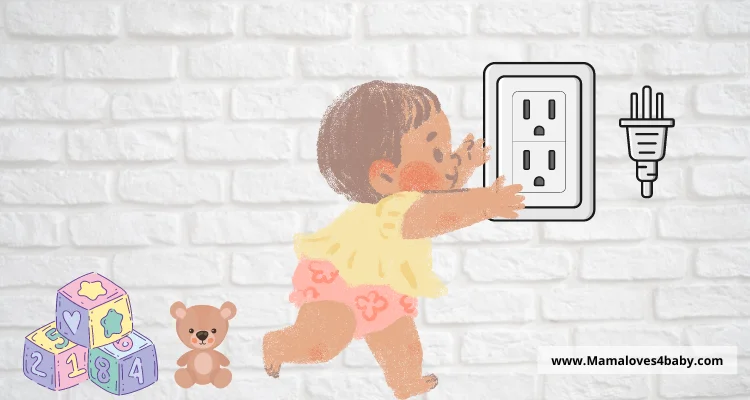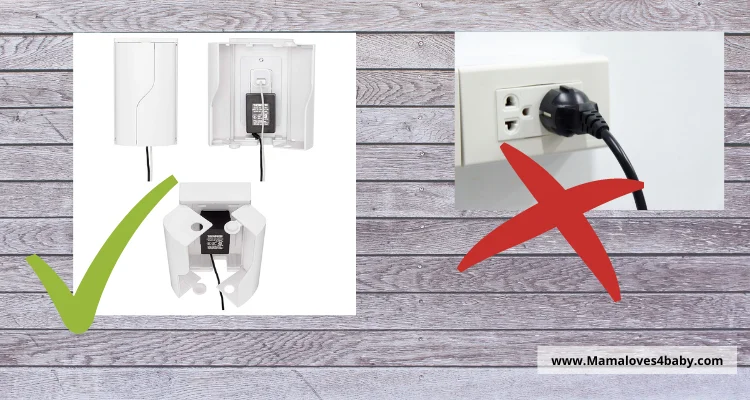One of the biggest dangers to your baby is cords and electrical outlets. Babyproofing your home can help protect your child from these dangers. Here are some valuable tips to help you with how to baby proof cords and electrical outlets to ensure your children stay safe as they grow up!

When you’re a mom, it’s hard to juggle everything. From taking care of your kids and doing housework all at once – there never seems to be enough time! But one thing that will make life easier for both baby AND parent? It is by securing the electrical outlets in every room so babies can’t get stuck on their little fingers when they play with their Electric Toys. Babies are curious little bundles, aren’t they?!
In this article, we cover the following:
- What electric cords and outlets are dangerous for babies
- The benefits of babyproofing cords
- How to cover baby monitor cord?
- Tips for securing electric cords, extension cables, and outlets with plastic caps
- How to choose the right safety products for your home
- And more!
Electric long cords and outlets can be a significant danger for babies. Some common dangers include getting stuck in an outlet, tangled up in cords, or electrocuted if they bite into a cord.
According to a US consumer product safety report, Electrical outlets and cords are one of the biggest causes of baby-related injuries. Over 24,000 children were admitted to the emergency room due to electrical receptacles in just ten years! It is an average of seven per day, and 89% are under six.
Luckily, some simple steps are to babysit your home and keep your child safe.
There are many benefits to baby proof your home, including protecting your child from potential dangers. Some ways to baby proof your home include securing electrical wires and outlets, using sliding plate covers on an empty outlet, and installing plug protectors on plug holes.
When choosing safety products for your home, it is essential to research and select products specifically designed for babyproofing. It can include looking for products that are sturdy, easy to install, and made from durable materials.
Read Also: How to babyproof a fireplace with best fireplace safety gate? and How to block stairs without baby gate?
How To Baby proof cords and electrical Outlets effectively?
When babyproofing your electrical outlets, it is essential to remember that the goal is not just to cover up the outlets and prevent access. Instead, it will be best if you secure the outlet to ensure safety while still being accessible when needed. Some potential solutions for how to babyproof electrical outlets include:
- Install outlet covers, such as those that screw into place, or use safety plugs and clips to hold the plug securely.
- Use outlet covers with built-in sensors, such as tamper-resistant outlets or GFCIs.
- Use outlet covers that are designed to be fire-safe, such as AFCIs.
- Install a safety socket that can be used to disable the electric outlets when not in use.
Types of Electrical outlets
One thing to remember while baby proofing occupied outlets are to be mindful of potential hazards. For this, parents must be aware of the types of electrical outlets.
Tamper-resistant
The tamper-resistant outlet has an outer plate that is pulled out once a plug has been placed in the outlet. It provides a great solution to prevent childhood shocks with electrical outlets. It has built-in safety shutters that open only when you insert a grounded plug.
GFCI outlets
Another outlet to consider when babyproofing your home is the ground fault circuit interrupter. This type of outlet is designed to automatically detect abnormalities in the flow of electricity, such as water touching the wires. If a GFCI outlet detects an electrical abnormality, it immediately shuts off the power to prevent potential safety hazards.
AFCI outlets
Another type of outlet to consider is the arc fault circuit interrupter or AFCI. Like the GFCI outlet, the AFCI monitors and senses abnormalities in the flow of electricity. However, unlike a GFCI outlet, an AFCI responds to abnormal electrical arcs rather than ground faults. An AFCI can detect overheating or arcing wires, often leading to electrical fires.
Overall, there are many different strategies that you can use to safely babyproof your electrical outlets and help keep your little ones safe. By being mindful of potential hazards, taking the necessary precautions, and using the proper safety tools, people can ensure that their home is safe and secure for their family.

Types Of Electrical Outlet Covers
You can take several steps to babyproof your electrical outlets and prevent these dangerous incidents from happening. One effective way to do this is to use covers for your outlets, which can help prevent accidental shocks and electrocution.
Electrical outlet covers are an essential part of baby proofing your home. They’re usually located in places that babies and toddlers can easily reach. Since they contain live wires, they must be covered up to avoid danger or injury.
There are several different types of electrical outlet covers. Some are made of plastic, metal, and others have a hard rubber coating. Many brands offer both different styles of covers as well as different sizes.
Plastic outlet cover
A plastic cover is the most common type of electrical outlet cover. They are commonly found in homes, daycares, and other public places. Plastic covers are easy to use and can be removed easily by an adult if needed. However, they can be difficult or impossible for a child to remove independently. Plastic covers also come in different colors and styles, making it easier to find the right cover for your decor.
Babyproofing empty outlets
When it comes to babyproofing your home, one of the most critical tasks is covering up any empty outlets. These can be a safety hazard for young children, who may try to stick their fingers or other small objects inside.
There are a few different options for babyproofing empty outlets. You can install plastic covers, which are typically easy to use and remove.
Power Gear Plastic Outlet Covers, 30 Pack
Safety 1st OutSmart Outlet Shield
Babyproofing occupied outlets
When babyproofing occupied outlets, there are several different tools and strategies that you can use. One popular option is to use outlet covers, which come in many different styles and sizes to fit your needs.
Other options include plug covers, which help keep the electrical plugs safely inside the outlet. You can also use outlet plugs, which cover the entire outlet and prevent access to dangerous wires or electrical components.
Dreambaby Dual Fit Outlet Plug Cover
Safety Innovations Twin Door Baby Safety Outlet Cover Box for Babyproofing Outlets
Metal cover
A metal cover is another type of electrical outlet cover that can be used to babyproof your home. If you’re concerned about your child gaining access to exposed cords or wires, you might prefer a metal cover over other styles. Metal covers can be installed quickly and easily, often with a screwdriver.
Once the cover is in place, it’s nearly impossible for your child to remove it independently. Metal covers are often made of a single piece of metal or two pieces connected with a hinge.
TayMac MX3200 RaynGuard Extra Duty Metal Weatherproof In-Use Cover
Rubber cover
A rubber version of the electrical outlet cover is another popular choice for babyproofing your home. Rubber covers are usually more challenging to install than plastic or metal ones, but they may be better if you have small children who tend to chew on things.
The rubber material will be more difficult for your child to bite or pull off the outlet, resulting in fewer choking hazards. Rubber covers are also typically made from a single piece of material that can be attached to the wall with adhesive or screws.
TAYMAC ML500W Single-Gang Mount 16-in-1 Flat Nonmetallic Weatherproof Vertical/Horizontal
Self closing outlets covers
Another type of electrical outlet cover you might consider is sliding covers with spring loaded shutters. These covers typically have a latch, hinge, or other mechanisms that automatically slide over the outlet after unplugging cords. It can help prevent your child from accidentally touching the live wires inside and getting an electric shock.
If you’re looking for a durable, high-quality electrical outlet cover that will last for years, you may want to consider a self-closing cover. These covers are typically made from heavy-duty materials like steel or hard plastic and can withstand even the most vigorous tug or pull.
Jambini Self-Closing Baby Proof Outlet Covers Baby Proofing
How To Babyproof Electrical Cords?
Regarding babyproofing your home, you should consider protecting your child from long cable, which can cause strangulation risk to the baby. You can do this in several ways, depending on the specific situation.
How to cover the baby monitor cord?
One of the easiest ways to baby proof cords and outlets is to cover them up with protective cord sleeves or protectors. These sleeves are available in a great range of styles and sizes to help keep your little one safe and prevent them from getting injured.
There are a few different ways to baby proof cords, including using a baby monitor cord cover, taping down cords with duct tape, or placing plastic electrical outlet caps over unused outlets and power strips.
How to hide baby monitor cord?
One of the easiest ways to hide your baby monitor cord is to tuck it behind heavy furniture or other objects in your home. When you have young children in the home, it is essential to baby proof electrical outlets and power strips and to keep them safe from electrical shock.
Ways to Babyproof Electrical Cords
One effective way to use cord or outlet covers to babyproof power cords. These are typically plastic or rubber sleeves that you can slide over cords to keep little hands from being able to reach them. You can find these covers in various colors and sizes, quickly finding ones that match your home’s decor.
Wiremold Floor Cord Management Kit
Another option for baby proofing cords on floor is to tape down the cords with duct tape. It will help keep them out of reach while allowing you to use the cords when needed. To do this, run a strip of duct tape along the top of your cord where little hands would usually reach. You can also secure the tape by placing a few small nails or thumbtacks along the edges of the tape.
The Original Duck Tape Brand 284358 Duct Tape
How to baby proof plugged in cords?
How do I stop my toddler from pulling out the plugs? Consider using a cord shortener if you are looking for an effective way to use babyproof plugged cords.
Cord shortener
How to cover baby monitor cord? This device helps you. You can attach this to the end of your long cords to shorten them and keep them out of reach. Many cord shorteners are designed with built-in safety features, such as rounded or recessed ends, which help further protect little hands from getting caught or injured.
Looking for a reliable and affordable cord shortener for babyproofing cords? Check out these
Safety 1st Outlet Cover with Cord Shortener for Baby Proofing
Dreambaby Electrical Cord Shortener
Wrap cords
The simple way to wrap and keep cords out of reach is to use duct cord covers. You can use it to wrap up your cords quickly and securely fasten them in place, preventing little hands from being able to reach them.
How to baby proof power strips?
Power strips or extension cord is more dangerous for kids as it is composed of multiple cords in one place. The best way to baby proof power strip is to use plastic power strip covers.
Safety 1st Power Strip Cover for Baby Proofing electrical outlets and cords
10 Things parents can do to support electrical safety in the home
How do you baby proof cords in Australia?Well follow these guidelines
- Keep electric cords and wires out of reach of children to prevent them from chewing or pulling on them.
- How to keep toddler from unplugging cords? Use safety siding pate covers to cover regular outlets, especially those on the floor or low down on a wall where little hands can easily reach them.
- Never leave electrical appliances, like hair straighteners or curling irons, plugged in and turned on when they are not used.
- Use extension cords or power strips with built-in safety features like child-proof outlets and automatic shut-off timers to reduce the risk of electrical fires and accidents.
- Replace any damaged electric cords immediately, as these can easily cause electrical fires or shocks.
- Always watch kids near electric outlets, power strips, and appliances, and never leave them unattended in the kitchen or around the water.
- Teach kids about electrical safety by reading books, watching educational videos, or visiting websites that teach about the dangers of electrical devices and how to stay safe around them.
- Regularly check electrical outlets for signs of wear and tear, and replace or repair them as needed to prevent electrical hazards.
- Invest in safety products like tamper-resistant receptacles, cord winders, cord cover for baby monitor and safety latches to further reduce the risk of electrical accidents in your home.
- Practice good electrical safety habits, like turning off the lights when you leave a room and unplugging appliances when they are not in use, to set an excellent example for your kids and help them learn these necessary safety skills.
5 Things children can do to support electrical safety in the home
- Teach children never to touch electric cords or outlets, even if they think they are broken or inactive.
- Show children where electric cords and outlets are located in their homes, and explain the potential hazards associated with these areas.
- Get help from an adult whenever children need to use or plug in appliances, such as lamps, vacuums, or small kitchen appliances.
- Keep small objects like paper clips and rubber bands away from most power strips and power bars, as these items can sometimes get stuck inside them.
- Encourage children to speak up if they see someone else in their home playing with or tampering with electric cords or outlets, and help them find an adult to intervene if needed.


